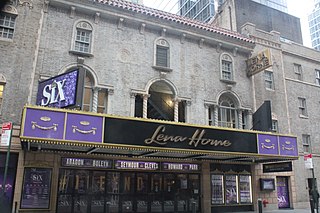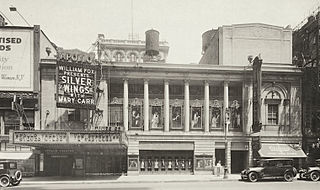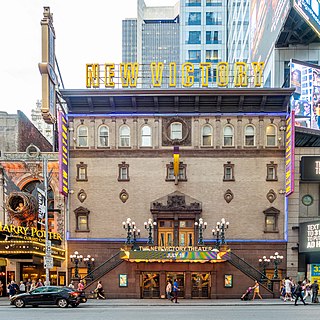
The Imperial Theatre is a Broadway theater at 249 West 45th Street in the Theater District of Midtown Manhattan in New York City. Opened in 1923, the Imperial Theatre was designed by Herbert J. Krapp and was constructed for the Shubert brothers. It has 1,457 seats across two levels and is operated by The Shubert Organization. The auditorium interior is a New York City designated landmark.

The New Amsterdam Theatre is a Broadway theater at 214 West 42nd Street, at the southern end of Times Square, in the Theater District of Manhattan in New York City. One of the first Broadway venues to open in the Times Square neighborhood, the New Amsterdam was built from 1902 to 1903 to designs by Herts & Tallant. The theater is operated by Disney Theatrical Productions and has 1,702 seats across three levels. Both the Beaux-Arts exterior and the Art Nouveau interior of the building are New York City landmarks, and the building is on the National Register of Historic Places.

The Neil Simon Theatre, originally the Alvin Theatre, is a Broadway theater at 250 West 52nd Street in the Theater District of Midtown Manhattan in New York City. Opened in 1927, the theater was designed by Herbert J. Krapp and was built for Alex A. Aarons and Vinton Freedley. The original name was an amalgamation of Aarons's and Freedley's first names; the theater was renamed for playwright Neil Simon in 1983. The Neil Simon has 1,467 seats across two levels and is operated by the Nederlander Organization. Both the facade and the auditorium interior are New York City landmarks.

The Bernard B. Jacobs Theatre is a Broadway theater at 242 West 45th Street in the Theater District of Midtown Manhattan in New York City. Opened in 1927, the theater was designed by Herbert J. Krapp in a Spanish style and was built for real-estate developer Irwin S. Chanin. It has 1,100 seats across two levels and is operated by The Shubert Organization. Both the facade and the auditorium interior are New York City landmarks.

The August Wilson Theatre is a Broadway theater at 245 West 52nd Street in the Theater District of Midtown Manhattan in New York City. Opened in 1925, the theater was designed by C. Howard Crane and Kenneth Franzheim and was built for the Theatre Guild. It is named for Pulitzer Prize-winning playwright August Wilson (1945–2005). The August Wilson has approximately 1,225 seats across two levels and is operated by Jujamcyn Theaters. The facade is a New York City designated landmark.

The St. James Theatre, originally Erlanger's Theatre, is a Broadway theater at 246 West 44th Street in the Theater District of Midtown Manhattan in New York City. Opened in 1927, it was designed by Warren and Wetmore in a neo-Georgian style and was constructed for A. L. Erlanger. It has 1,709 seats across three levels and is operated by Jujamcyn Theaters. Both the facade and the auditorium interior are New York City landmarks.

The Broadway Theatre is a Broadway theater at 1681 Broadway in the Theater District of Midtown Manhattan in New York City. Opened in 1924, the theater was designed by Eugene De Rosa for Benjamin S. Moss, who originally operated the venue as a movie theater. It has approximately 1,763 seats across two levels and is operated by The Shubert Organization. The Broadway Theatre is one of the few Broadway theaters that is physically on Broadway.

The Walter Kerr Theatre, previously the Ritz Theatre, is a Broadway theater at 219 West 48th Street in the Theater District of Midtown Manhattan in New York City. The theater was designed by Herbert J. Krapp and was constructed for the Shubert brothers in 1921. The venue, renamed in 1990 after theatrical critic Walter Kerr, has 975 seats across three levels and is operated by Jujamcyn Theaters. The facade is plainly designed and is made of patterned brick. The auditorium contains Adam-style detailing, two balconies, and murals.

The Nederlander Theatre is a Broadway theater at 208 West 41st Street in the Theater District of Midtown Manhattan in New York City. Opened in 1921, it was designed by William Neil Smith for theatrical operator Walter C. Jordan. It has around 1,235 seats across two levels and is operated by the Nederlander Organization. Since 1980, it has been named for American theater impresario David Tobias Nederlander, father of theatrical producer James M. Nederlander. It is the southernmost Broadway theater in the Theater District.

The Longacre Theatre is a Broadway theater at 220 West 48th Street in the Theater District of Midtown Manhattan in New York City, United States. Opened in 1913, it was designed by Henry B. Herts and was named for Longacre Square, now known as Times Square. The Longacre has 1,077 seats and is operated by The Shubert Organization. Both the facade and the auditorium's interior are New York City designated landmarks.

The Lyric Theatre is a Broadway theater at 214 West 43rd Street in the Theater District of Midtown Manhattan in New York City. Opened in 1998, the theater was designed by Richard Lewis Blinder of Beyer Blinder Belle, in collaboration with Peter Kofman, for Garth Drabinsky and his company Livent. The Lyric Theatre was built using parts of two former theaters on the site: the Apollo Theatre, built in 1920 to a design by Eugene De Rosa, and the old Lyric Theatre, built in 1903 to a design by Victor Hugo Koehler. The theater contains 1,622 seats across three levels and is operated by Ambassador Theatre Group (ATG). The theater building is owned by the city and state governments of New York and was developed by New 42nd Street.

The Lena Horne Theatre is a Broadway theater at 256 West 47th Street in the Theater District of Midtown Manhattan in New York City. Opened in 1926, it was designed by Herbert J. Krapp in a Spanish Revival style and was constructed for Irwin Chanin. It has 1,069 seats across two levels and is operated by the Nederlander Organization. Both the facade and the auditorium interior are New York City landmarks.

The American Airlines Theatre, originally the Selwyn Theatre, is a Broadway theater at 227 West 42nd Street in the Theater District of Midtown Manhattan in New York City. Built in 1918, it was designed by George Keister and developed by brothers Edgar and Archibald Selwyn, for whom the theater was originally named. The theater is owned by the city and state governments of New York and leased to New 42nd Street. It has 740 seats across two levels and is operated by Roundabout Theatre Company. Since 2000, the theater has been named for American Airlines (AA), which bought the theater's naming rights.

The Times Square Theater is a former Broadway and movie theater at 217 West 42nd Street in the Theater District of Midtown Manhattan in New York City, near Times Square. Built in 1920, it was designed by Eugene De Rosa and developed by brothers Edgar and Archibald Selwyn. The building, which is no longer an active theater, is owned by the city and state governments of New York and leased to New 42nd Street.

The New Victory Theater is a theater at 209 West 42nd Street in the Theater District of Midtown Manhattan in New York City, near Times Square. Built in 1900 as the Republic Theatre, it was designed by Albert Westover and developed by Oscar Hammerstein I as a Broadway theater. The theater has been known by several names over the years, including the Belasco Theatre, Minsky's Burlesque, and the Victory Theatre. The theater is owned by the city and state governments of New York and leased to nonprofit New 42nd Street, which has operated the venue as a children's theater since 1995. The New Victory presents theater shows, dance shows, puppet shows, and other types of performance art shows from all around the world.

The Hudson Theatre is a Broadway theater at 139–141 West 44th Street, between Seventh Avenue and Sixth Avenue, in the Theater District of Midtown Manhattan in New York City. One of the oldest surviving Broadway venues, the Hudson was built from 1902 to 1903. The exterior was designed by J. B. McElfatrick & Son, while Israels & Harder oversaw the completion of the interior. The theater has 970 seats across three levels. Both its exterior and interior are New York City designated landmarks, and the theater is on the National Register of Historic Places.

The Liberty Theatre is a former Broadway theater at 234 West 42nd Street in the Theater District of Midtown Manhattan in New York City. Opened in 1904, the theater was designed by Herts & Tallant and built for Klaw and Erlanger, the partnership of theatrical producers Marc Klaw and A. L. Erlanger. The theater has been used as an event venue since 2011 and is part of an entertainment and retail complex developed by Forest City Ratner. The theater is owned by the city and state governments of New York and leased to New 42nd Street. Brookfield Asset Management, which acquired Forest City in 2018, subleases the venue from New 42nd Street.

The Empire Theatre is a former Broadway theater at 234 West 42nd Street in the Theater District of Midtown Manhattan in New York City. Opened in 1912, the theater was designed by Thomas W. Lamb for the Hungarian-born impresario A. H. Woods. It was originally named for female impersonator Julian Eltinge, a performer with whom Woods was associated. In 1998, the building was relocated 168 feet (51 m) west of its original location to serve as the entrance to the AMC Empire 25, a multiplex operated by AMC Theatres, which opened in April 2000.

Village East by Angelika is a movie theater at 189 Second Avenue, on the corner with 12th Street, in the East Village of Manhattan in New York City. Part of the former Yiddish Theatre District, the theater was designed in the Moorish Revival style by Harrison Wiseman and built from 1925 to 1926 by Louis Jaffe. In addition to Yiddish theatre, the theater has hosted off-Broadway shows, burlesque, and movies. Since 1991, it has been operated by Angelika Film Center as a seven-screen multiplex. Both the exterior and interior of the theater are New York City designated landmarks, and the theater is on the National Register of Historic Places.

The Sam H. Harris Theatre, originally the Candler Theatre, was a theater within the Candler Building, at 226 West 42nd Street, in the Theater District of Midtown Manhattan in New York City. Opened in 1914, the 1,200-seat theater was designed by Thomas W. Lamb and built for Asa Griggs Candler, who leased it to George M. Cohan, Sam H. Harris, and George Kleine. Although the theater was intended to host both movies and legitimate Broadway productions, it functioned exclusively as a movie theater after 1933. The theater's auditorium was demolished by 1998. The only remnant of the former theater is its 42nd Street facade, which has been used by the Madame Tussauds New York museum since 2000.






















